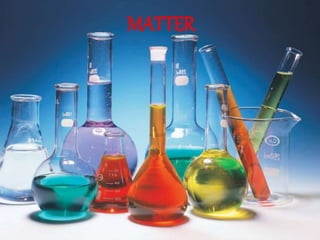
PPT ON CHAPTER-MATTER AND IT SURROUNDING
- 1. MATTER
- 2. 1. Define matter. 2. What is an atom? Give an example . 3. Define molecule. Give an example. 4. What are homoatomic and heteroatomic molecules? Give an example of each. 1. Define matter. 2. What is an atom? Give an example . 3. Define molecule. Give an example. 4. What are homoatomic and heteroatomic molecules? Give an example of each.
- 3. MATTER Matter is anything which has mass, occupies space and can be perceived by our senses.
- 4. * According to JOHN DALTON ,all kinds of matter are made up of extremely small particles called atoms.
- 5. * ATOM: Atom is the smallest particle of the matter exhibits all the properties of matter, usually do not have independent existence . Example: Hydrogen atom: H MOLECULE: Atoms combined with each other to form the molecules having independent existence. Hydrogen molecule: 𝑯𝟐
- 6. * PARTICLES OF MATTER VERY SMALL HAVING INTERMOLECULAR SPACE IN CONSTANT RANDOM MOTION ATTRACT EACH OTHER
- 7. Observation: The solution in all the beakers are coloured though they become fainter due to successive dilution. Conclusion: A small crystal of potassium permanganate contains a very large number of tiny particles which shows all the properties of matter.
- 8. * Observation : There is no increase in the level of water in the beaker. Conclusion :There must be some space between the particles of matter in which the salt or sugar particles get accommodated when dissolved.
- 9. BROWNIAN MOTION: The random motion of the suspended particles on the surface of a liquid or in air is called brownian motion. Observation: Pollen grains were moving throughout the water in a zig-zag or irregular manner. Conclusion: As water is also made up of tiny particles which are also in random motion. The pollen grains move in such a way because they collide with the moving particles of water.
- 10. Diffusion: The intermixing of two or more substances due to the motion of their particles in order to get a uniform mixture is called diffusion Observation: The reddish Brown vapours also spread out into the upper jar. Conclusion: The rate of diffusion is the fastest in gases and slowest in solids. It increases with increase in temperature.
- 11. * Question: Why a piece of chalk can be broken easily while a piece of coal requires a greater force to break and a metal piece cannot be broken easily? Answer; Magnitude of force of attraction between the particles called as intermolecular force of attraction and it varies from matter to matter. More is the force ,difficult to break it. Increasing order of intermolecular force of attraction in three type of matter is : Chalk < coal < iron
- 12. STATES OF MATTER :- SOLIDS • DEFINITE SHAPE AND DEFINITE VOLUME • EXAMPLE :- WOOD,STONE , ETC . LIQUIDS • DEFINITE VOLUME BUT NO DEFINITE SHAPE • EXAMPLE :- WATER, MILK, ETC . GASES • NEITHER A DEFINITE SHAPE NOR A DEFINITE VOLUME • EXAMPLE:- AIR, OXYGEN, ETC .